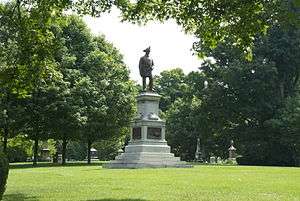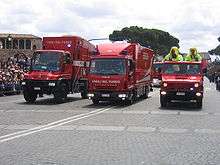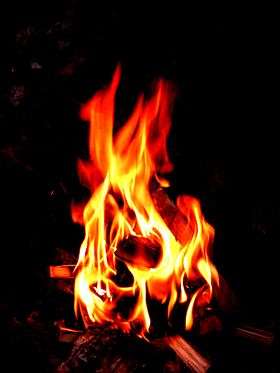Firefighter
A firefighter (also known as a fireman or firewoman) is a rescuer extensively trained in firefighting, primarily to extinguish hazardous fires that threaten life, property, and the environment as well as to rescue people and animals from dangerous situations.
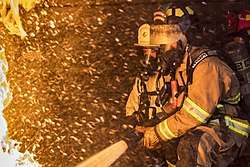 Pair of firefighters extingushing a blaze using a water hose | |
| Occupation | |
|---|---|
Activity sectors | Rescue, fire protection, civil service, public service, public safety, |
The complexity of modern, industrialized life has created an increase in the skills needed in firefighting technology. The fire service, also known in some countries as the fire brigade or fire department, is one of the three main emergency services. From urban areas to aboard ships, firefighters have become ubiquitous around the world.
The skills required for safe operations are regularly practiced during training evaluations throughout a firefighter's career. Initial firefighting skills are normally taught through local, regional or state-approved fire academies or training courses.[1] Depending on the requirements of a department, additional skills and certifications such as technical rescue and pre-hospital medicine may also be acquired at this time.
Firefighters work closely with other emergency response agencies such as the police and emergency medical service. A firefighter's role may overlap with both. Fire investigators or fire marshals investigate the cause of a fire. If the fire was caused by arson or negligence, their work will overlap with law enforcement. Firefighters also frequently provide some degree of emergency medical service, in addition to working with full-time paramedics.
The basic tasks of firefighters include: fire suppression, rescue, fire prevention, basic first aid, and investigations. Firefighting is further broken down into skills which include: size-up, extinguishing, ventilation, search and rescue, salvage, containment, mop up and overhaul.
Duties
Fire suppression

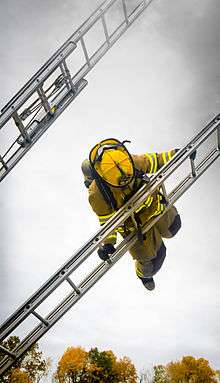
A fire burns due to the presence of three elements: fuel, oxygen and heat. This is often referred to as the fire triangle. Sometimes it is known as the fire tetrahedron if a fourth element is added: a chemical chain reaction which can help sustain certain types of fire. The aim of firefighting is to deprive the fire of at least one of those elements. Most commonly this is done by dousing the fire with water, though some fires require other methods such as foam or dry agents. Firefighters are equipped with a wide variety of equipment for this purpose that include: ladder trucks, pumper trucks, tanker trucks, fire hose, and fire extinguishers.
Structural firefighting
- See also Fire suppression for other techniques.
While sometimes fires can be limited to small areas of a structure, wider collateral damage due to smoke, water and burning embers is common. Utility shutoff (such as gas and electricity) is typically an early priority for arriving fire crews. In addition, forcible entry may be required in order to gain access into the structure. Specific procedures and equipment are needed at a property where hazardous materials are being used or stored.
Structure fires may be attacked with either "interior" or "exterior" resources, or both. Interior crews, using the "two in, two out" rule, may extend fire hose lines inside the building, find the fire and cool it with water. Exterior crews may direct water into windows and other openings, or against any nearby fuels exposed to the initial fire. Hose streams directed into the interior through exterior wall apertures may conflict and jeopardize interior fire attack crews.
Buildings that are made of flammable materials such as wood are different from building materials such as concrete. Generally, a "fire-resistant" building is designed to limit fire to a small area or floor. Other floors can be safe by preventing smoke inhalation and damage. All buildings suspected or on fire must be evacuated, regardless of fire rating.
Some fire fighting tactics may appear to be destructive, but often serve specific needs. For example, during ventilation, firefighters are forced to either open holes in the roof or floors of a structure (called vertical ventilation), or open windows and walls (called horizontal ventilation) to remove smoke and heated gases from the interior of the structure. Such ventilation methods are also used to improve interior visibility to locate victims more quickly. Ventilation helps to preserve the life of trapped or unconscious individuals as it releases the poisonous gases from inside the structure. Vertical ventilation is vital to firefighter safety in the event of a flashover or backdraft scenario. Releasing the flammable gases through the roof eliminates the possibility of a backdraft, and the removal of heat can reduce the possibility of a flashover. Flashovers, due to their intense heat (900–1200° Fahrenheit) and explosive temperaments, are commonly fatal to firefighter personnel. Precautionary methods, such as smashing a window, reveal backdraft situations before the firefighter enters the structure and is met with the circumstance head-on. Firefighter safety is the number one priority.
Whenever possible during a structure fire, property is moved into the middle of a room and covered with a salvage cover, a heavy cloth-like tarp. Various steps such as retrieving and protecting valuables found during suppression or overhaul, evacuating water, and boarding windows and roofs can divert or prevent post-fire runoff.
Wildland firefighting
Wildfires (known in Australia as bushfires) require a unique set of strategies and tactics. In many countries such as Australia and the United States, these duties are mostly carried out by local volunteer firefighters. Wildfires have some ecological role in allowing new plants to grow, therefore in some cases they will be left to burn.[2] Priorities in fighting wildfires include preventing the loss of life and property.
Rescue
.jpg)
Firefighters rescue people (and animals) from dangerous situations such as crashed vehicles, structural collapses, trench collapses, cave and tunnel emergencies, water and ice emergencies, elevator emergencies, energized electrical line emergencies, and industrial accidents.[3] In less common circumstances, Firefighters rescue victims from hazardous materials emergencies as well as steep cliffs, embankment and high rises - The latter is referred to as High Angle Rescue, or Rope Rescue. Many fire departments, including most in the United Kingdom, refer to themselves as a fire and rescue service for this reason. Large fire departments, such as the New York City Fire Department and London Fire Brigade, have specialist teams for advanced technical rescue. As building fires have been in decline for many years in developed countries such as the United States, rescues other than fires make up an increasing proportion of their firefighters' work.[4]
Emergency medical services
Firefighters frequently provide some degree of emergency medical care. In some jurisdictions first aid is the only medical training that firefighters have, and medical-only calls are the sole responsibility of a separate emergency medical services (EMS) agency. Elsewhere, it is common for firefighters to respond to medical-only calls. The impetus for this is the growing demand for emergency medicine and the decline of fires and traditional firefighting call-outs[4]—though fire departments still have to be able to respond to them—and their existing ability to respond rapidly to emergencies. A rapid response is particularly necessary for cardiac arrests, as these will lead to death if not treated within minutes.[5]
The dispatch of firefighters to medical emergencies is particularly common in fire departments that run the EMS, including most large cities of the United States. In those departments, firefighters are often jointly trained as emergency medical technicians in order to deliver basic life support, and more rarely as paramedics to deliver advanced life support. In the United Kingdom, where fire services and EMS are run separately, fire service co-responding has been introduced more recently.[6] Another point of variation is whether the firefighters respond in a fire engine or a response car.[7] Either way, separate employees to crew ambulances are still needed, unless the firefighters can work shifts on the ambulances.
Specialized roles
Aircraft rescue & firefighting
Airports employ specialist firefighters to deal with potential ground emergencies. Due to the mass casualty potential of an aviation emergency, the speed with which emergency response equipment and personnel arrive at the scene of the emergency is of paramount importance. When dealing with an emergency, the airport firefighters are tasked with rapidly securing the aircraft, its crew and its passengers from all hazards, particularly fire. Airport firefighters have advanced training in the application of firefighting foams, dry chemical and clean agents used to extinguish burning aviation fuel.
Hazardous materials
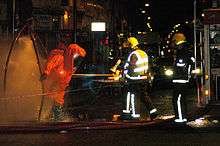
Fire departments are usually the primary agency that responds to an emergency involving hazardous materials. Specialized firefighters, known as hazardous materials technicians, have training and certification in chemical identification, leak control, decontamination, and clean-up procedures.
Fire prevention

Fire departments frequently provide advice to the public on how to prevent fires in the home and work-place environments. Fire inspectors or fire marshals will directly inspect businesses to ensure they are up to the current building fire codes,[8][9] which are enforced so that a building can sufficiently resist fire spread, potential hazards are located, and to ensure that occupants can be safely evacuated, commensurate with the risks involved.
Fire suppression systems have a proven record for controlling and extinguishing unwanted fires. Many fire officials recommend that every building, including residences, have fire sprinkler systems.[10] Correctly working sprinklers in a residence greatly reduce the risk of death from a fire.[11] With the small rooms typical of a residence, one or two sprinklers can cover most rooms. In the United States, the housing industry trade groups have lobbied at the State level to prevent the requirement for Fire Sprinklers in 1 and 2 bedroom homes.[12][13]
Other methods of fire prevention are by directing efforts to reduce known hazardous conditions or by preventing dangerous acts before tragedy strikes. This is normally accomplished in many innovative ways such as conducting presentations, distributing safety brochures, providing news articles, writing public safety announcements (PSA) or establishing meaningful displays in well-visited areas. Ensuring that each household has working smoke alarms, is educated in the proper techniques of fire safety, has an evacuation route and rendezvous point is of top priority in public education for most fire prevention teams in almost all fire department localities.
Fire investigators, who are experienced firefighters trained in fire cause determinism, are dispatched to fire scenes, in order to investigate and determine whether the fire was a result of an accident or intentional. Some fire investigators have full law enforcement powers to investigate and arrest suspected arsonists.
Occupational health and safety
Direct risks
Fires
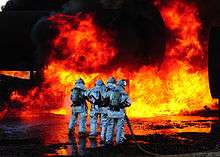
To allow protection from the inherent risks of fighting fires, firefighters wear and carry protective and self-rescue equipment at all times. A self-contained breathing apparatus (SCBA) delivers air to the firefighter through a full face mask and is worn to protect against smoke inhalation, toxic fumes, and super heated gases. A special device called a Personal Alert Safety System (PASS) is commonly worn independently or as a part of the SCBA to alert others when a firefighter stops moving for a specified period of time or manually operates the device. The PASS device sounds an alarm that can assist another firefighter (firefighter assist and search team (FAST), or rapid intervention team (RIT), in locating the firefighter in distress.
Firefighters often carry personal self-rescue ropes. The ropes are generally 30 feet long and can provide a firefighter (that has enough time to deploy the rope) a partially controlled exit out of an elevated window. Lack of a personal rescue rope is cited in the deaths of two New York City Firefighters, Lt. John Bellew and Lt. Curtis Meyran, who died after they jumped from the fourth floor of a burning apartment building in the Bronx. Of the four firefighters who jumped and survived, only one of them had a self-rescue rope. Since the incident, the Fire Department of New York City has issued self-rescue ropes to their firefighters.[14]
Heat injury is a major issue for firefighters as they wear insulated clothing and cannot shed the heat generated from physical exertion. Early detection of heat issues is critical to stop dehydration and heat stress becoming fatal. Early onset of heat stress affects cognitive function which combined with operating in dangerous environment makes heat stress and dehydration a critical issue to monitor. Firefighter physiological status monitoring is showing promise in alerting EMS and commanders to the status of their people on the fire ground. Devices such as PASS device alert 10–20 seconds after a firefighter has stopped moving in a structure. Physiological status monitors measure a firefighter's vital sign status, fatigue and exertion levels and transmit this information over their voice radio. This technology allows a degree of early warning to physiological stress. These devices[15] are similar to technology developed for Future Force Warrior and give a measure of exertion and fatigue. They also tell the people outside a building when they have stopped moving or fallen. This allows a supervisor to call in additional engines before the crew get exhausted and also gives an early warning to firefighters before they run out of air, as they may not be able to make voice calls over their radio. Current OSHA tables exist for heat injury and the allowable amount of work in a given environment based on temperature, humidity and solar loading.[16]
Firefighters are also at risk for developing rhabdomyolysis. Rhabdomyolysis is the breakdown of muscle tissue and has many causes including heat exposure, high core body temperature, and prolonged, intense exertion. Routine firefighter tasks, such as carrying extra weight of equipment and working in hot environments, can increase firefighters’ risk for rhabdomyolysis.[17][18]
Structural collapses
Another leading cause of death during firefighting is structural collapse of a burning building (e.g. a wall, floor, ceiling, roof, or truss system). Structural collapse, which often occurs without warning, may crush or trap firefighters inside the structure. To avoid loss of life, all on-duty firefighters should maintain two-way communication with the incident commander and be equipped with a personal alert safety system device on all fire scenes and maintain radio communication on all incidents(PASS).[19][20] Francis Brannigan was the founder and greatest contributor to this element of firefighter safety.
Traffic collisions
In the United States, 25% of fatalities of firefighters are caused by traffic collisions while responding to or returning from an incident. Other firefighters have been injured or killed by vehicles at the scene of a fire or emergency (Paulison 2005). A common measure fire departments have taken to prevent this is to require firefighters to wear a bright yellow reflective vest over their turnout coats if they have to work on a public road, to make them more visible to passing drivers.[21] In addition to the direct dangers of firefighting, cardiovascular diseases account for approximately 45% of on duty firefighter deaths.[22]
Violence
Firefighters have sometimes been assaulted by members of the public while responding to calls. These kinds of attacks can cause firefighters to fear for their safety and may cause them to not have full focus on the situation which could result in injury to their selves or the patient.
During debris cleanup
Once extinguished, fire debris cleanup poses several safety and health risks for workers.[23][24]
Many hazardous substances are commonly found in fire debris. Silica can be found in concrete, roofing tiles, or it may be a naturally occurring element. Occupational exposures to silica dust can cause silicosis, lung cancer, pulmonary tuberculosis, airway diseases, and some additional non-respiratory diseases.[25] Inhalation of asbestos can result in various diseases including asbestosis, lung cancer, and mesothelioma.[26] Sources of metals exposure include burnt or melted electronics, cars, refrigerators, stoves, etc. Fire debris cleanup workers may be exposed to these metals or their combustion products in the air or on their skin. These metals may include beryllium, cadmium, chromium, cobalt, lead, manganese, nickel, and many more.[23] Polyaromatic hydrocarbons (PAHs), some of which are carcinogenic, come from the incomplete combustion of organic materials and are often found as a result of structural and wildland fires.[27]
Safety hazards of fire cleanup include the risk of reignition of smoldering debris, electrocution from downed or exposed electrical lines or in instances where water has come into contact with electrical equipment. Structures that have been burned may be unstable and at risk of sudden collapse.[24][28]
Standard personal protective equipment for fire cleanup include hard hats, goggles or safety glasses, heavy work gloves, earplugs or other hearing protection, steel-toe boots, and fall protection devices.[28][29] Hazard controls for electrical injury include assuming all power lines are energized until confirmation they are de-energized, and grounding power lines to guard against electrical feedback, and using appropriate personal protective equipment.[28] Proper respiratory protection can protect against hazardous substances. Proper ventilation of an area is an engineering control that can be used to avoid or minimize exposure to hazardous substances. When ventilation is insufficient or dust cannot be avoided, personal protective equipment such as N95 respirators can be used.[28][30]
Long-term risks
Cardiovascular disease
Firefighting has long been associated with poor cardiovascular outcomes. In the United States, the most common cause of on-duty fatalities for firefighters is sudden cardiac death. In addition to personal factors that may predispose an individual to coronary artery disease or other cardiovascular diseases, occupational exposures can significantly increase a firefighter's risk. Historically, the fire service blamed poor firefighter physical condition for being the primary cause of cardiovascular related deaths. However, over the last 20 years, studies and research has indicated the toxic gasses put fire service personnel at significantly higher risk for cardiovascular related conditions and death. For instance, carbon monoxide, present in nearly all fire environments, and hydrogen cyanide, formed during the combustion of paper, cotton, plastics, and other substances containing carbon and nitrogen. The substances inside of materials change during combustion their bi-products interfere with the transport of oxygen in the body. Hypoxia can then lead to heart injury. In addition, chronic exposure to particulate matter in smoke is associated with atherosclerosis. Noise exposures may contribute to hypertension and possibly ischemic heart disease. Other factors associated with firefighting, such as stress, heat stress, and heavy physical exertion, also increase the risk of cardiovascular events.[31]
During fire suppression activities a firefighter can reach peak or near peak heart rates which can act as a trigger for a cardiac event. For example, tachycardia can cause plaque buildup to break loose and lodge itself is a small part of the heart causing myocardial infarction, also known as a heart attack. This along with unhealthy habits and lack of exercise can be very hazardous to firefighter health.[32]
Cancer
._(40730256683).jpg)
A 2015 retrospective longitudinal study showed that firefighters are at higher risk for certain types of cancer. Firefighters had mesothelioma, which is caused by asbestos exposure, at twice the rate of the non-firefighting working population. Younger firefighters (under age 65) also developed bladder cancer and prostate cancer at higher rates than the general population. The risk of bladder cancer may be present in female firefighters, but research is inconclusive as of 2014.[33][34] Preliminary research from 2015 on a large cohort of US firefighters showed a direct relationship between the number of hours spent fighting fires and lung cancer and leukemia mortality in firefighters. This link is a topic of continuing research in the medical community, as is cancer mortality in general among firefighters.[35]
Firefighters are exposed to a variety of carcinogens at fires, including both carcinogenic chemicals and radiation (alpha radiation, beta radiation, and gamma radiation).[36]
Mental stress
As with other emergency workers, firefighters may witness traumatic scenes during their careers. They are thus more vulnerable than most people to certain mental health issues such as post-traumatic stress disorder[37][38] and suicidal thoughts and behaviors.[39][40] Among women in the US, the occupations with the highest suicide rates are police and firefighters, with a rate of 14.1 per 100 000, according to the National Center for Injury Prevention and Control, CDC.[41] Chronic stress over time attributes to symptoms that affect first responders, such as anxiousness, irritability, nervousness, memory and concentration problems can occur overtime which can lead to anxiety and depression. Mental stress can have long lasting affects on the brain.[42] A 2014 report from the National Fallen Firefighters Foundation found that a fire department is three times more likely to experience a suicide in a given year than a line-of-duty death.[43] Mental stress of the job can lead to substance abuse and alcohol abuse as ways of coping with the stress.[44] The mental stress of fire fighting has a lot of different causes. There are those they see on duty and also what they miss by being on duty. Firefighters schedules fluctuate by district. There are stations where fire fighters work 48 hours on and 48 hours off. Some allow 24 hours on and 72 hours off[45] . The mental impact of missing your child's first steps or a ballet recital can take a heavy impact on first responders. There is also the stress of being on opposite shifts as your spouse or being away from family.
Occupational hearing loss
Another long-term risk factor from firefighting is exposure to high levels of sound, which can cause noise-induced hearing loss (NIHL) and tinnitus.[46][47] NIHL affects sound frequencies between 3,000 and 6,000 Hertz first, then with more frequent exposure, will spread to more frequencies.[47] Many consonants will be more difficult to hear or inaudible with NIHL because of the higher frequencies effected, which results in poorer communication.[47] NIHL is caused by exposure to sound levels at or above 85dBA according to NIOSH and at or above 90dBA according to OSHA.[47] dBA represents A-weighted decibels. dBA is used for measuring sound levels relating to occupational sound exposure since it attempts to mimic the sensitivity of the human ear to different frequencies of sound.[47] OSHA uses a 5-dBA exchange rate, which means that for every 5dBA increase in sound from 90dBA, the acceptable exposure time before a risk of permanent hearing loss occurs decreases by half (starting with 8 hours acceptable exposure time at 90dBA).[47][48] NIOSH uses a 3-dBA exchange rate starting at 8 hours acceptable exposure time at 85dBA.[47][49]
The time of exposure required to potentially cause damage depends on the level of sound exposed to.[49] The most common causes of excessive sound exposure are sirens, transportation to and from fires, fire alarms, and work tools.[46] Traveling in an emergency vehicle has shown to expose a person to between 103 and 114dBA of sound. According to OSHA, exposure at this level is acceptable for between 17 and 78 minutes[48] and according to NIOSH is acceptable for between 35 seconds and 7.5 minutes [49] over a 24-hour day before permanent hearing loss can occur. This time period considers that no other high level sound exposure occurs in that 24-hour time frame.[49] Sirens often output about 120 dBA, which according to OSHA, 7.5 minutes of exposure is needed[48] and according to NIOSH, 9 seconds of exposure is needed[49] in a 24-hour time period before permanent hearing loss can occur. In addition to high sound levels, another risk factor for hearing disorders is the co-exposure to chemicals that are ototoxic.[50]
The average day of work for a firefighter can often be under the sound exposure limit for both OSHA and NIOSH.[47] While the average day of sound exposure as a firefighter is often under the limit, firefighters can be exposed to impulse noise, which has a very low acceptable time exposure before permanent hearing damage can occur due to the high intensity and short duration.[46]
There are also high rates of hearing loss, often NIHL, in firefighters, which increases with age and number of years working as a firefighter.[46][51] Hearing loss prevention programs have been implemented in multiple stations and have shown to help lower the rate of firefighters with NIHL.[47] Other attempts have been made to lower sound exposures for firefighters, such as enclosing the cabs of the firetrucks to lower the siren exposure while driving.[47] NFPA (National Fire Protection Association) is responsible for occupational health programs and standards in firefighters which discusses what hearing sensitivity is required to work as a firefighter, but also enforces baseline (initial) and annual hearing tests (based on OSHA hearing maintenance regulations).[46] While NIHL can be a risk that occurs from working as a firefighter, NIHL can also be a safety concern for communicating while doing the job as communicating with coworkers and victims is essential for safety.[46] Hearing protection devices have been used by firefighters in the United States.[47] Earmuffs are the most commonly used hearing protection device (HPD) as they are the most easy to put on correctly in a quick manner.[47] Multiple fire departments have used HPDs that have communication devices built in, allowing firefighters to speak with each other at safe, but audible sound levels, while lowering the hazardous sound levels around them.[47]
Types of coverage and workload
In a country with a comprehensive fire service, fire departments must be able to send firefighters to emergencies at any hour of day or night, to arrive on the scene within minutes. In urban areas, this means that full-time paid firefighters usually have shift work, with some providing cover each night. On the other hand, it may not be practical to employ full-time firefighters in villages and isolated small towns, where their services may not be required for days at a time. For this reason, many fire departments have firefighters who spend long periods on call to respond to infrequent emergencies; they may have regular jobs outside of firefighting. Whether they are paid or not varies by country. In the United States and Germany, volunteer fire departments provide most of the cover in rural areas. In the United Kingdom and Ireland, by contrast, actual volunteers are rare. Instead, "retained firefighters" are paid for responding to incidents, along with a small salary for spending long periods of time on call.
Firefighting around the world
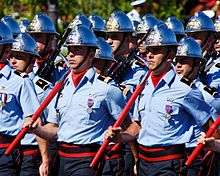
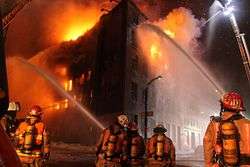
A key difference between many country's fire services is what the balance is between full-time and volunteer (or on-call) firefighters. In the United States and United Kingdom, large metropolitan fire departments are almost entirely made up of full-time firefighters. On the other hand, in Germany and Austria,[52] volunteers play a substantial role even in the largest fire departments, including Berlin's, which serves a population of 3.6 million. Regardless of how this balance works, a common feature is that smaller urban areas have a mix of full-time and volunteer/on-call firefighters. This is known in the United States as a combination fire department. In Chile and Peru, all firefighters are volunteers.[53]
Another point of variation is how the fire services are organized. Some countries like Israel and New Zealand have a single national fire service. Others like Australia, the United Kingdom and France organize fire services based on regions or sub-national states. In the United States, Germany and Canada, fire departments are run at a municipal level.
Atypically, Singapore and many parts of Switzerland have fire service conscription.[54][55] In Germany, conscription can also be used if a village does not have a functioning fire service. Other unusual arrangements are seen in France, where two of the country's fire services (the Paris Fire Brigade and the Marseille Naval Fire Battalion) are part of the armed forces, and Denmark, where most fire services are run by private companies.[56]
Another way in which a firefighter's work varies around the world is the nature of firefighting equipment and tactics. For example, American fire departments make heavier use of aerial appliances, and are often split between engine and ladder companies. In Europe, where the size and usefulness of aerial appliances are often limited by narrow streets, they are only used for rescues, and firefighters can rotate between working on an engine and an aerial appliance. [57][56] A final point in variation is how involved firefighters are in emergency medical services.
Communication and command structure
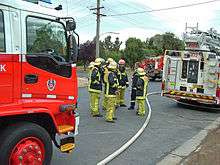
The expedient and accurate handling of fire alarms or calls are significant factors in the successful outcome of any incident. Fire department communications play a critical role in that successful outcome. Fire department communications include the methods by which the public can notify the communications center of an emergency, the methods by which the center can notify the proper fire fighting forces, and the methods by which information is exchanged at the scene. One method is to use a megaphone to communicate.
A telecommunicator (often referred to as a 000 Operator) has a role different from but just as important as other emergency personnel. The telecommunicator must process calls from unknown and unseen individuals, usually calling under stressful conditions. He/she must be able to obtain complete, reliable information from the caller and prioritize requests for assistance. It is the dispatcher's responsibility to bring order to chaos.
While some fire departments are large enough to utilize their own telecommunication dispatcher, most rural and small areas rely on a central dispatcher to provide handling of fire, rescue, and police services.
Firefighters are trained to use communications equipment to receive alarms, give and receive commands, request assistance, and report on conditions. Since firefighters from different agencies routinely provide mutual aid to each other, and routinely operate at incidents where other emergency services are present, it is essential to have structures in place to establish a unified chain of command, and share information between agencies. The U.S. Federal Emergency Management Agency (FEMA) has established a National Incident Management System.[58] One component of this system is the Incident Command System.
All radio communication in the United States is under authorization from the Federal Communications Commission (FCC); as such, fire departments that operate radio equipment must have radio licenses from the FCC.
Ten codes were popular in the early days of radio equipment because of poor transmission and reception. Advances in modern radio technology have reduced the need for ten-codes and many departments have converted to simple English (clear text).
Ranks
Many firefighters are sworn members with command structures similar to the military and police. They do not have general police powers (some firefighters in the United States have limited police powers, like fire police departments, while certain fire marshals have full police powers, i.e. the ability to make warrantless arrests, and authority to carry a firearm on and off-duty), but have specific powers of enforcement and control in fire and emergency situations.
The basic unit of an American fire department is a "company", a group of firefighters who typically work on the same engine. A "crew" or "platoon" is a subdivision of a company who work on the same shift. Commonwealth fire services are more likely to be organized around a "watch", who work the same shift on multiple engines.[59]
Australia
New South Wales Rural Fire Service
| Operational Rank | Membership Type | Insignia |
|---|---|---|
| Commissioner | NSW Government Senior Executive Service Officer |  |
| Assistant Commissioner | NSW Government Senior Executive Service Officer |  |
| Chief Superintendent | NSW Government Public Service Officer |  |
| Superintendent | NSW Government Public Service Officer |  |
| Inspector | NSW Government Public Service Officer |  |
| Group Captain | Volunteer |  |
| Deputy Group Captain | Volunteer |  |
| Captain | Volunteer |  |
| Senior Deputy Captain | Volunteer |  |
| Deputy Captain | Volunteer |  |
| Fire Fighter | Volunteer |  |
Belgium
New rank structure of 2015.
| Higher Cadre | |
|---|---|
 | Colonel |
 | Major |
 | Captain |
 | Lieutenant |
| Middle Cadre | |
 | Adjudant |
 | Sergeant |
| Basic Cadre | |
 | Corporal |
 | Firefighter |
Canada

Ranks amongst Canadian firefighters vary across the country and ranking appears mostly with larger departments:
Toronto
| Rank | Insignia |
|---|---|
| Probationary Firefighter | no rank |
| Second Class Firefighter | no rank |
| First Class Firefighter | no rank |
| Captain | 2 silver epaulette stripes |
| District Chief | 2 gold stripes |
| Platoon Chief | 3 gold stripes |
| Division Commander | 3 thick and 1 thin gold stripes |
| Deputy Fire Chief | 4 gold stripes |
| Fire Chief | 5 gold stripes |
Montreal
| Rank | Insignia |
|---|---|
| Firefighter/Firefighter Instructor | no rank |
| Interim Lieutenant | 1 white stripes |
| Lieutenant/Lieutenant Instructor | 2 white stripes |
| Captain | 3 white stripes |
| Operations Chief | 1 thick yellow stripes |
| Division Chief | 1 thick and 1 thin yellow stripes |
| Assistant Chief | 1 thick and 2 thin yellow stripes |
| Deputy Chief | 1 thick and 3 thin yellow stripes |
| Fire Chief | 1 thick and 4 thin yellow stripes plus star |
Vancouver
| Fire Chief | Deputy Fire Chief | Assistant Chief | Battalion Chief | Training Officer | Captain | Lieutenant | Firefighter | Probationary Firefighter | |
|---|---|---|---|---|---|---|---|---|---|
| Rank Epaulettes | 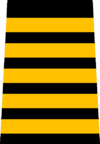 |
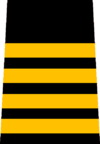 |
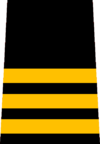 |
 |
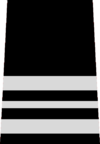 |
 |
 |
No Insignia | No Insignia |
| Rank Pins | .png) |
.png) |
.png) |
.png) |
.png) |
.png) |
.png) |
No Insignia | No Insignia |
Chile
Ranks are divided between Company Officers and Fire Department Officers, which can be subdivided between Active Officers (Field Officers) and Administrative Officers each. The active officers are the captain, and three or four lieutenants, these four active officers are distinguished by red lines on their helmets.
Commonwealth
Most fire brigades in Commonwealth countries (except Canada) have a more "civilianised" nomenclature, structured in a traditional manner. For example, the common structure in United Kingdom brigades is:
| Rank | Collar/epaulette markings | Helmet colour/pattern | Form of address |
|---|---|---|---|
| Firefighter Trainee | Red | Yellow helmet, often with the Trainee's surname written across to allow trainers to identify them | None |
| Firefighter Development | None | Yellow helmet with a red diamond indicating the Firefighter is capable of responding to fire calls, but is in the final stage of their training | None |
| Firefighter | None | Yellow helmet with no marking indicates a "competent" (fully trained) firefighter. | None |
| Crew Manager | Two chrome bars on blue | Yellow helmet with two 12.5mm horizontal black stripes | Crew |
| Watch Manager | Two impellers on blue | White helmet with one 12.5mm horizontal black stripe | Watch (informally “Sub”, because of the former UK rank of Sub-Officer) |
| Station Manager | Three impellers on blue | White helmet with one 19mm horizontal black stripe | Sir/Ma'am (informally “Governor” or “Guv”) |
| Group Manager | One impeller inside wreath on blue | White helmet with one 12.5mm and one 19mm horizontal black stripes | Sir/Ma'am |
| Area Manager | One chrome bar and one impeller inside wreath on blue | White helmet with two 19mm horizontal black stripes | Sir/Ma'am |
| Deputy Chief Fire Officer | One chrome bar, one impeller and one large impeller inside wreath on blue | White helmet with one 38mm horizontal black stripe | Sir/Ma'am |
| Chief Fire Officer | Two impellers and one large impeller inside wreath on blue | White helmet with one 38mm horizontal black stripe | Sir/Ma'am |
Denmark
| Rank Epaulettes[60] |  |
 |
 |
 |
 |
 |
 |
 |
 |
 |
 |
|---|---|---|---|---|---|---|---|---|---|---|---|
| Direct translation of Danish ranks | Emergency Director/ Emergency Chief |
Deputy Emergency Director/ Deputy Emergency Chief |
Department Chief/ Area Chief |
Area Manager | Fire Inspector | Deputy Fire Inspector/ Station Master |
Emergency Master/ Fire Master |
Deputy Emergency Master/ Deputy Fire Master |
Part-time Team Leader with instructor skills | Part-time Team Leader | Fire Assistant/ Emergency Assistant |
| Equivalent in London Fire Brigade | Commissioner | Deputy Commissioner | Assistant Commissioner | Deputy Assistant Commissioner | Group Manager | Station Manager | Station Officer | Sub-Officer | no equivalent | no equivalent | Firefighter |
France
French civilian fire services, which historically are derived from French army sapper units, use French Army ranks. The highest rank in many departments is full colonel. Only the NCO rank of major is used in both the Paris Fire Brigade and the Marseille Naval Fire Battalion; since 2013 it has been abolished in the other fire departments.
- Ministry of Interior



- Civilian Fire Services (Professional Fire Fighters Class A+)


- Civilian Fire Services (Professional Fire Fighters Class A)



- Civilian Fire Services (Professional Fire Fighters Class B)

- Civilian Fire Services (Professional Fire Fighters Class C)







Germany
In Germany every federal state has its own civil protection laws thus they have different rank systems. Additionally, in the volunteer fire departments, there is a difference between a rank and an official position. This is founded on the military traditions of the fire departments. Every firefighter can hold a high rank without having an official position. A firefighter can be promoted by years of service, training skills and qualifications. Official positions are partly elected or given by capabilities. These conditions allow that older ordinary firefighters have higher ranks than their leaders. But through this ranks are no authorities given (Brevet).
- Professional Fire Fighters (Middle Technical Grades) of Rheinland-Pfalz
Completed vocational training in a technical occupation suitable for the fire service. Basic firefighter training.
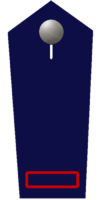 |
 |
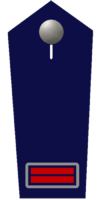 |
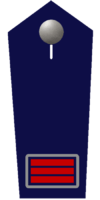 |
| Brandmeister/-in während der Laufbahnausbildung | Brandmeister | Oberbrandmeister | Hauptbrandmeister |
- Professional Fire Fighters (Upper Technical Grades) of Rheinland-Pfalz
Bachelor of Engineering and two years departmental training.
 |
 |
 |
 |
 |
 |
| Brandinspektorenanwärter | Brandinspektor | Brandoberinspektor | Brandamtmann | Brandamtsrat | Brandoberamtsrat |
- Professional Fire Fighters (Higher Technical Grades) of Rheinland-Pfalz
Master of Engineering and two years of departmental training.
 |
 |
 |
 |
 |
 |
 |
| Brandreferendar | Brandrat | Oberbrandrat | Branddirektor | Leitender Branddirektor Ministerialrat | Leitender Ministerialrat | Landesfeuerwehrinspekteur |
- Helmet insignia of Rheinland-Pfalz
 |
 |
 |
| Company Leaders | Upper Technical Grades, Battalion Chiefs | Higher Technical Grades, Fire Chiefs |
Indonesia
Firefighters in Indonesia form part of the civil service of local governments and wear variant forms of uniforms worn by civil servants and employees.
| Rank category | Rank category number | Rank in Indonesian | Equivalent rank (with US General Schedule and UK Civil Service paygrade) |
Rank in English (Regional Fire Service personnel only) |
|---|---|---|---|---|
| Commissioners General | IV/e | Pembina Utama | Permanent Secretary Senior Executive Service Level III |
Commissioner General |
| IV/d | Pembina Utama Madya | Director General Senior Executive Service Level III, Pay Band 3 A7 |
Deputy Commissioner General | |
| IV/c | Pembina Utama Muda | Director Senior Executive Service Level IV, Pay Band 2 A7 |
Superintendent General | |
| IV/b | Pembina Tingkat I | Deputy Director Senior Executive Service Level V, Pay Band 1 A7 |
Fire Director | |
| IV/a | Pembina | Assistant Director GS-15, Grade 6 A6 |
Commissioner | |
| Senior ranked officers | III/d | Penata Tingkat I | Senior Executive Officer 1st class GS-14, Grade 7 A5 |
Chief Superintendent |
| III/c | Penata | Senior Executive Officer GS-13, Grade 7 A4 |
Superintendent | |
| III/b | Penata Muda Tingkat I | Higher Executive Officer GS-12, A3 |
Battalion Chief | |
| Junior ranked officers | III/a | Penata Muda | Executive Officer 1st class GS-11, A2/B6 |
Fire Captain |
| II/d | Pengatur Tingkat I | Executive Officer 2nd class GS-10, A2/B6 |
Fire Lieutenant | |
| II/c | Pengatur | Executive Officer GS-9, A1/B5 |
Divisional Inspector | |
| Senior clerical officials | II/b | Pengatur Muda Tingkat I | Administrative Officer Class 1 GS-8, B4 |
Station Sub-officer |
| II/a | Pengatur Muda | Administrative Officer Class 2 GS-7, B4 |
Sergeant Major | |
| Junior clerical officials | I/d | Juru Tingkat I | Higher Clerical Officer 1st class GS-6/GS-5, B3 |
Sergeant |
| I/c | Julu | Higher Clerical Officer GS-4/GS-3, B3 |
Corporal | |
| I/b | Julu Muda Tingkat I | Clerical Officer GS-2, B2 |
Leading Firefighter | |
| I/a | Julu Muda | Administrative Assistant GS-1, B1 |
Firefighter | |
Italy
The Vigili del Fuoco, (literally the word "Vigili" comes from the Latin word "Vigiles", which means "who is part of certain guards") have the official name of Corpo nazionale dei vigili del fuoco (CNVVF, National Firefighters Corps).
The CNVVF is the Italian institutional agency for fire and rescue service. It is part of the Ministry of Interior's Department of Firefighters, Public Rescue and Public Protection. The CNVVF task is to provide safety for people, animals and property, and control the compliance of buildings and industries to fire safety rules. The Ministry of the Interior, through the CNVVF, adopts fire safety rules with ministerial decrees or other lower rank documents. The CNVVF also ensures public rescue in emergencies that involves the use of chemical weapons, bacteriological, radiological and materials. Since 2012 the Corps uses its own rank titles (dating from 2007) with matching military styled insignia in honor of its origins.
In 2016 the CNVVF has been committed in forest firefighting activities together with the regional forest agencies, following the suppression of the National Forest Guards, which were merged into the Carabinieri (firefighters were integrated into the CNVVF). .
| Directors general |
|---|
| Dirigente generale capo del corpo |
| Dirigente generale |
| Dirigente superiore |
| Primo dirigente |
| Directors |
| Direttore vice dirigente |
| Direttore |
| Vice direttore |
| Substitute Fire Directors |
| Sostituto direttore antincendi capo |
| Sostituto direttore antincendi |
| Fire inspectors |
| Ispettore antincendi esperto |
| Ispettore antincendi |
| Vice ispettore antincendi |
| Non-commissioned officers |
| Capo reparto esperto |
| Capo reparto |
| Capo squadra esperto |
| Capo squadra |
| Enlisted firefighters |
| Vigile coordinatore |
| Vigile esperto |
| Vigile qualificato |
| Vigile del fuoco |
| Volunteer firefighters |
| Funzionario tecnico antincendi |
| Capo reparto volontario |
| Capo squadra volontario |
| Vigile volontario |
Iran
In Iran, every city has its own fire department, but ranks are the same in the whole country, and are as follows:
| Rank | Persian | Collar/epaulette markings | Collar/epaulette markings (in Persian) |
|---|---|---|---|
| Volunteer Firefighter I | آتش نشان داوطلب | One yellow bar | یک خط زرد |
| Volunteer Firefighter II | آتش نشان داوطلب دوم | Two yellow bars | دو خط زرد |
| Volunteer Firefighter III | آتش نشان داوطلب سوم | Three yellow bars | سه خط زرد |
| Firefighter I | آتش نشان | One silver bar | یک خط نقره ای |
| Firefighter II | آتش نشان دوم | Two silver bars | دو خط نقره ای |
| Firefighter III | آتش نشان سوم | Three silver bars | سه خط نقره ای |
| Head Firefighter I | سرآتش نشان | One flame and one gold bar | یک شعله و یک خط طلایی |
| Head Firefighter II | سرآتش نشان دوم | One flame and Two gold bars | یک شعله و دو خط طلایی |
| Head Firefighter III | سرآتش نشان سوم | One flame and Three gold bars | یک شعله و سه خط طلایی |
| Master Firefighter I | سر آتش یار | One flame | یک شعله |
| Master Firefighter II | آتش یار | Two flames | دو شعله |
| Master Firefighter III | آتش یار دوم | Three flames | سه شعله |
| Master Firefighter IV | آتش یار سوم | Four flames | چهار شعله |
| Chief Firefighter I | آتش پاد | One empty gold wreath | یک حلقه گل طلایی خالی |
| Chief Firefighter II | آتش پاد دوم | One gold wreath with a flame inside | یک حلقه گل طلایی با یک شعله درونش |
| Chief Firefighter III | آتش پاد سوم | One gold wreath with a flame inside and a silver bar below them | یک حلقه گل طلایی با یک شعله درونش و یک خط نقره ای زیر آنها |
| Chief master Firefighter I | فرآتش پاد | One gold wreath with a flame inside and two silver bars below them | یک حلقه گل طلایی با یک شعله درونش و دو خط نقره ای زیر آنها |
| Chief master Firefighter II | فرآتش پاد دوم | One gold wreath with a flame inside and three silver bars below them | یک حلقه گل طلایی با یک شعله درونش و سه خط نقره ای زیر آنها |
| Chief master Firefighter III | فرآتش پاد سوم | One gold wreath with a flame inside and four silver bars below them | یک حلقه گل طلایی با یک شعله درونش و چهار خط نقره ای زیر آنها |
Ireland
In Ireland, the traditional brigade rank structure is still adopted. Below is the common structure for most brigades, Cork and Dublin Fire Brigade have additional ranks:
| Rank | Helmet colour/markings |
|---|---|
| Firefighter | Plain Yellow Helmet) |
| Leading Firefighter/Driver Mechanic in retained brigades | Yellow Helmet with one 12.5mm horizontal black stripe |
| Sub Officer | Yellow Helmet with two 12mm black stripes |
| Station Officer | White helmet with one 19mm horizontal black stripe |
| Assistant Chief Fire Officer | ? |
| Senior Assistant Chief Fire Officer | White helmet with one 38mm horizontal black stripe |
| Chief Fire Officer | White helmet with two 38mm horizontal black stripe |
Japan
Japanese Fire Department's rank insignias are place on a small badge and pinned above the right pocket. Rank is told by stripes and Hexagram stars. The design of the insignias came from older Japanese style military insignias. Officers and Team Leaders could wear an arm band on the arm of fire jacket to show status as command leader. Sometimes rank can be shown as different color fire jacket for command staff. The color whites and gray are reserved for EMS. Orange is reserved for rescuer.
Firefighter
|
Assistant Fire Sergeant
|
Fire Sergeant
|
Fire Lieutenant
|
Fire Captain
|
Battalion Chief
|
Assistant Chief
|
1st Assistant Chief
|
Deputy Chief
|
Fire Chief
|
Luxembourg
Grand-Ducal Fire and Rescue Corps of Luxembourg.
- Basic Cadre of Professional and Volunteer Fire Fighters
 Aspirant Brigadier
Aspirant Brigadier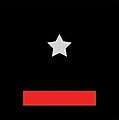 Brigadier
Brigadier Corporal
Corporal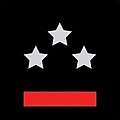 Chief Corporal
Chief Corporal Chief Corporal 1st Class
Chief Corporal 1st Class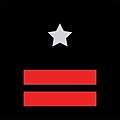 Sergeant
Sergeant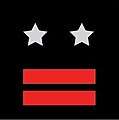 Chief Sergeant
Chief Sergeant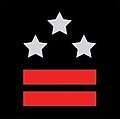 Sergeant major
Sergeant major
- Middle Cadre of Professional and Volunteer Fire Fighters
 Aspirant Adjutant
Aspirant Adjutant Adjutant
Adjutant Chief Adjutant
Chief Adjutant Adjutant major
Adjutant major
- Higher Cadre of Professional and Volunteer Fire Fighters
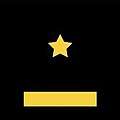 Aspirant Lieutenant
Aspirant Lieutenant Lieutenant
Lieutenant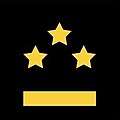 Lieutenant 1st Class
Lieutenant 1st Class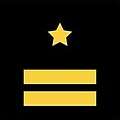 Captain
Captain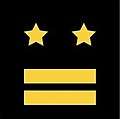 Major
Major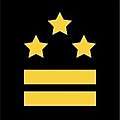 Lieutenant Colonel
Lieutenant Colonel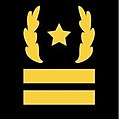 Colonel
Colonel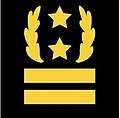 Director General
Director General
Malaysia
| # | Rank | Abbreviation | Rank (English) | Grade | Epaulet | |
|---|---|---|---|---|---|---|
| Shoulder board | Collar badge | |||||
| Penguasa Bomba (Fire Superintendent) | ||||||
| 1 | Ketua Pesuruhjaya Bomba | KPjB | Chief Fire Commissioner | JUSA A | ||
| 2 | Pesuruhjaya Bomba | PjB | Fire Commissioner | JUSA B | ||
| 3 | Timbalan Pesuruhjaya Bomba | TPjB | Deputy Fire Commissioner | JUSA C | ||
| 4 | Penolong Kanan Pesuruhjaya Bomba | PKPjB | Senior Assistant Fire Commissioner | KB 54 | ||
| 5 | Penolong Pesuruhjaya Bomba | PPjB | Assistant Fire Commissioner | KB 52 | ||
| 6 | Penguasa Kanan Bomba I | PgKB I | Senior Fire Superintendent I | KB 48 | ||
| 7 | Penguasa Kanan Bomba II | PgKB II | Senior Fire Superintendent II | KB 44 | ||
| 8 | Penguasa Bomba | PgB | Fire Superintendent | KB 41 | ||
| Penolong Penguasa Bomba (Assistant Fire Superintendent) | ||||||
| 9 | Timbalan Penguasa Bomba | TPgB | Deputy Fire Superintendent | KB 38 | ||
| 10 | Penolong Kanan Penguasa Bomba | PKPgB | Senior Assistant Fire Superintendent | KB 32 | ||
| 11 | Penolong Penguasa Bomba | PPgB | Assistant Fire Superintendent | KB 29 | ||
| Pegawai Bomba (Fire Officer) | ||||||
| 12 | Pegawai Bomba Tinggi | PBT | Leading Fire Officer | KB 26 | ||
| 13 | Pegawai Bomba Kanan I | PBK I | Senior Fire Officer I | KB 24 | ||
| 14 | Pegawai Bomba Kanan II | PBK II | Senior Fire Officer II | KB 22 | ||
| 15 | Pegawai Bomba | PB | Fire Officer | KB 17 / 19 | No Insignia | |
Netherlands
 | Hoofdcommandeur | Fire Chief |
 | Adjunct-Hoofdcommandeur | Deputy Fire Chief |
 | Commandeur | Division Chief |
 | Hoofdbrandmeester | Battalion Chief |
 | Brandmeester | Captain |
 | Hoofdbrandwacht | Engineer |
 | Brandwacht | Fire Fighter |
 | Algemene / Aspirantfuncties | Trainee |
New Zealand
In New Zealand, rank is shown on epaulettes on firefighters' station uniform, and through colors and stripes on firefighter helmets. As the nation only has a single fire department, the New Zealand Fire Service, ranks are consistent through the country.
| Rank | Epaulette[61] | Helmet[61] |
|---|---|---|
| Trainee Firefighter (TFF) | plain | fluro-green |
| Firefighter (FF) | one hollow bar | yellow |
| Qualified Firefighter (QFF) | one solid bar | yellow, one red stripe |
| Senior Firefighter (SFF) | two solid bars | yellow, two red stripes |
| Station Officer (SO) | one impeller | red, one blue stripe |
| Senior Station Officer (SSO) | two impellers | red, two blue stripes |
| Deputy Chief Fire Officer (DCFO) | impeller between two ferns below one impeller | white, one blue stripe |
| Chief Fire Officer (CFO) | impeller between two ferns below two impellers | white, two blue stripes |
| Assistant Area Commander (AAC) | three impellers | silver |
| Area Commander (AC) | one impeller below a crown | silver, one blue stripe |
| Assistant National Commander (ANC) | three impellers trefoil below a crown | silver, two blue stripes |
| Deputy National Commander (DNC) | silver crossed sword and baton below an impeller | black |
| National Commander (NC) | silver crossed sword and baton below a crown | black |
Poland
 |  | |||
Firefighter Private | Senior Firefighter Private | |||
 |  |  |  |  |
Section Leader Private 1st Class | Senior Section Leader Specialist | Junior Firemaster Corporal | Firemaster Sergeant | Senior Firemaster Staff Sergeant |
 |  |  |  | |
Junior Aspirant Sergeant 1st Class | Aspirant Master Sergeant | Senior Aspirant Sergeant Major | Staff Aspirant Command Sergeant Major | |
 |  |  |  | |
Junior Captain Second Lieutenant | Captain First Lieutenant | Senior Captain Captain | Junior Brigadier Major | |
 |  |  |  | |
Brigadier Lieutenant Colonel | Senior Brigadier Colonel | Chief Brigadier Brigadier General | General Brigadier Major General |
Russian Federation
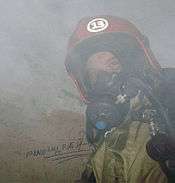
In the Russian Federation, the decals are applied symmetrically on both sides of the helmet (front and rear). The location of the decals on the special clothing and SCBA is established for each fire department of the same type within the territorial entity. The following ranks are used by State Fire Service civilian personnel, while military personnel use ranks similar to those of the Police of Russia, due to their pre-2001 history as the fire service of the Ministry of Internal Affairs of the Russian Federation before all firefighting services were transferred to the Ministry of Emergency Situations.
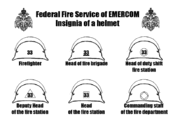
| Rank | Helmet colour/markings |
|---|---|
| Firefighter | The all color helmet with the applied number, indicating the fire station |
| Head of fire brigade | The all color helmet with the applied number, indicating the fire station, underlined by line 50 mm wide and 5 mm thick |
| Head of duty shift fire station | The all color helmet with the applied a circle, inside which the applied number is indicating the fire station |
| Deputy Head of the fire station | The all color helmet with the applied a triangle, inside which the applied number is indicating the fire station |
| Head of the fire station | The all color helmet with the applied a square, inside which the applied number is indicating the fire station |
| Commanding staff of the fire department | The all color helmet with the applied a circle, inside which the applied a rhombus |
Tunisia
Tunisian firefighter's ranks are actually the same as the army, police and national garde.
United Kingdom
| Rank title | Rank marking |
|---|---|
| Firefighter | |
| Leading Firefighter | |
| Sub-Officer | |
| Station Officer | |
| Station Manager | |
| Group Manager | |
| Deputy Assistant Commissioner | |
| Assistant Commissioner | |
| Deputy Commissioner | |
| Commissioner for Fire and Emergency Planning |
United States of America
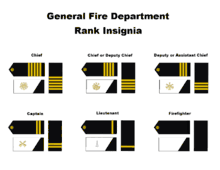
In the United States, helmet colors often denote a fire fighter's rank or position. In general, white helmets denote chief officers, while red helmets may denote company officers, but the specific meaning of a helmet's color or style varies from region to region and department to department. The rank of an officer in an American fire department is most commonly denoted by a number of speaking trumpets, a reference to a megaphone-like device used in the early days of the fire service, although typically called "bugle" in today's parlance. Ranks proceed from one (lieutenant) to five (fire chief) bugles. Traditional ranks in American fire departments that exist but may not always be utilized in all cities or towns include:
Firefighter
|
Engineer/Technician/Sergeant
|
Lieutenant
|
Captain
|
Battalion Chief/District Chief
|
Division Chief or Assistant /Deputy Asst.
Chief/Commissioner
|
Deputy Chief/Commissioner
|
Chief/Commissioner
|
In many fire departments in the U.S., the captain is commonly the commander of a company and a lieutenant is the supervisor of the company's firefighters on shift. There is no state or federal rank structure for firefighters and each municipality or volunteer fire department creates and uses their own unique structure.
Still, some other American fire departments such the FDNY use military rank insignia in addition or instead of the traditional bugles. Additionally, officers on truck companies have been known to use rank insignias shaped like axes for Lieutenants (1) and Captains (2).
Firefighter equipment
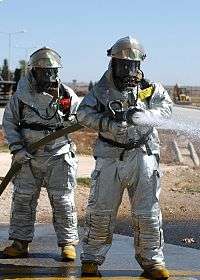 Turkish firefighters in MOPP 4 level protective gear during an exercise held at Incirlik Air Base, Turkey
Turkish firefighters in MOPP 4 level protective gear during an exercise held at Incirlik Air Base, Turkey Toronto firefighters prepare their equipment
Toronto firefighters prepare their equipment- A firefighter using a hydraulic cutter during a demonstration

A partial list of some equipment typically used by firefighters:
- Hand tools, such as
- Flat-head and pick-head axe
- Pike pole
- Halligan bar
- Flashlight
- Spanner wrench
- Circular ("K-12"), Cutters Edge and chain saws
- Hydraulic rescue tools such as spreaders, cutters, and rams
- Personal protective equipment ("PPE") designed to withstand water and high temperatures, such as
- Bunker gear, including turnout jacket and pants
- Self-contained breathing apparatus (SCBA)
- Helmet, face mask and visor; climbing helmets
- Safety boots, gloves, and Nomex and Carbon flash hoods
- Personal alert safety system (PASS) device
- Handheld radio, pager, or other communication devices
- Thermal imaging camera
- Gas detector
History
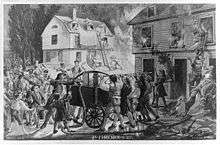
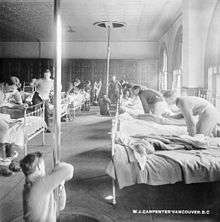
Although people have fought fires since there have been valuable things to burn, the first instance of organized professionals combating structural fires occurred in ancient Egypt. Likewise, fire fighters of the Roman Republic existed solely as privately organized and funded groups that operated more similarly to a business than a public service; however, during the Principate period, Augustus revolutionized firefighting by calling for the creation of a fire guard that was trained, paid, and equipped by the state, thereby commissioning the first truly public and professional firefighting service. Known as the Vigiles, they were organised into cohorts, serving as a night watch and city police force.
The earliest American fire departments were volunteers, including the volunteer fire company in New Amsterdam, now known as New York.[62] Fire companies were composed of citizens who volunteered their time to help protect the community. As time progressed and new towns were established throughout the region, there was a sharp increase in the number of volunteer departments.
In 1853, the first career fire department in the United States was established in Cincinnati, Ohio, followed four years later by St. Louis Fire Department. Large cities began establishing paid, full-time staff in order to try facilitate greater call volume.
City fire departments draw their funding directly from city taxes and share the same budget as other public works like the police department and trash services. The primary difference between municipality departments and city departments is the funding source. Municipal fire departments do not share their budget with any other service and are considered to be private entities within a jurisdiction. This means that they have their own taxes that feed into their budgeting needs. City fire departments report to the mayor, whereas municipal departments are accountable to elected board officials who help maintain and run the department along with the chief officer staff.
Fundraisers
Funds for firefighting equipment may be raised by the firefighters themselves, especially in the case of volunteer organizations. Events such as pancake breakfasts and chili feeds are common in the United States. Social events are used to raise money include dances, fairs, and car washes.
Notable firefighters
- James Braidwood (1800–1861), founder of the municipal fire brigade in Edinburgh, 1824
- John Decker (1823–1892), chief of the New York City department during the 1863 draft riots
- Raúl Gándara-Cartagena (1895–1989), first and longest-serving Puerto Rico commonwealth fire chief
- James J. Kenney (1869–1918), Berkeley, California, politician, the city's first fire chief
- Louis R. Nowell (1915–2009), Los Angeles, California, City Council member, a firefighter for 23 years
- Chip Prather (born 1953), second chief of the Orange County, California, Fire Authority
- Vladimir Pravik (1962–1986), Soviet firefighter who worked in the Chernobyl disaster, died on 11 May from acute radiation sickness
- Joseph Pfeifer, New York City, New York, Chief of counterterrorism and emergency preparedness, was the first to make an official report of 9/11 and headed the operations at WTC
- Walter Thomas (1922–2017), Fort Saskatchewan, Alberta, the longest serving firefighter in Canada[63]
- Gary Speakman (born 1983), former wholetime firefighter for GMFRS in the UK, two-time Guinness World Record holder for running marathons in full fire department uniform and breathing apparatus.[64][65]
See also
- Firefighting apparatus
- Firefighting – Actions to protect people, animals, goods, lands, and other objects from fire
- Firefighter arson
- History of firefighting
- Incident Command System
- Index of firefighting articles – Wikipedia index
- Occupational hazards of fire debris cleanup – Conditions caused by fire presenting health and safety hazards to cleanup crews
- Rescue
- Smokejumper
- Volunteer fire department
- Wildfire suppression – Firefighting tactics used to suppress wildfires
- Wildland Firefighter Foundation
- Women in firefighting
References
- "Fire Academy". Public Safety Elite. Retrieved 2016-03-10.
- Forest Fire in Canada, Natural Resources Canada, 2008-06-05, archived from the original on 2009-05-30, retrieved 2009-05-01
- "Firefighter job profile". Prospects.ac.uk.
- "Plenty of firefighters, but where are the fires?". The Boston Globe. 2013-09-07. Retrieved 2017-09-22.
- "What Is Sudden Cardiac Arrest?". NHLBI. June 22, 2016. Archived from the original on 28 July 2016. Retrieved 16 August 2016.
- "News". www.london-fire.gov.uk. Archived from the original on 13 August 2017. Retrieved 5 May 2018.
- "Surrey firefighters called to almost 300 medical emergencies during co-responding trial". Surrey Advertiser. 9 May 2016. Retrieved 3 September 2018.
- "NFPA 5000 Building Construction and Safety Code". National Fire Protection Association (NFPA). Retrieved 8 July 2018.
- "Overview of the International Fire Code". International Code Council (ICC). 2015-03-20. Retrieved 8 July 2018.
- "NFPA Fire Sprinkler Initiative". National Fire Protection Association (NFPA). Retrieved 8 July 2018.
- Pollack, Keshia; Frattaroli, Shannon; Somers, Scott (August 24, 2015). "Research Shows Residential Sprinklers Save Lives" (Fire and Worker Health and Safety). SAGE Journal. Retrieved 8 July 2018.
- Faturechi, Robert (June 22, 2016). "The Fire Sprinkler War, State by State". Propublica. Retrieved 8 July 2018.
- "Anti-sprinkler legislation". National Fire Protection Association (NFPA). Retrieved 8 July 2018.
- James Barron (January 24, 2005). "3 Firefighters Die in Blazes in Brooklyn and Bronx". The New York Times.
- Zephyr Technologies BioHarness BT Archived 2010-04-07 at the Wayback Machine
- "OSHA Technical Manual (OTM) - Section III: Chapter IV: Heat Stress". Osha.gov. Retrieved 2012-12-10.
- "What structural fire fighters need to know about rhabdomyolysis" (PDF). 2018-05-01. doi:10.26616/nioshpub2018133. Cite journal requires
|journal=(help) - "What wildland fire fighters need to know about rhabdomyolysis" (PDF). 2018-05-01. doi:10.26616/nioshpub2018131. Cite journal requires
|journal=(help) - National Institute for Occupational Safety and Health Alert: Preventing Injuries and Deaths of Fire Fighters due to Structural Collapse. August 1999.
- National Institute for Occupational Safety and Health Alert: Preventing Injuries and Deaths of Fire Fighters Due to Truss System Failures. May 2005.
- Federal Highway Administration DOT 23CFR634 Worker Visibility
- Kales, Stefanos N.; Soteriades, Elpidoforos S.; Christophi, Costas A.; Christiani, David C. (2007). "The New England Journal of Medicine", March 22, 2007, Accessed:July 17, 2011". New England Journal of Medicine. 356 (12): 1207–1215. CiteSeerX 10.1.1.495.4530. doi:10.1056/NEJMoa060357. PMID 17377158.
- Beaucham, Catherine; Eisenberg, Judith (August 2019). "Evaluation of fire debris cleanup employees' exposure to silica, asbestos, metals, and polyaromatic hydrocarbons" (PDF). U.S. National Institute for Occupational Safety and Health.
- "Worker Safety and Health During Fire Cleanup". California Division of Occupational Safety and Health. April 2019. Retrieved 27 March 2020.
- "Health effects of occupational exposure to respirable crystalline silica". U.S. National Institute for Occupational Safety and Health. 2017-05-13. doi:10.26616/NIOSHPUB2002129.
- 29 C.F.R. 1910.1001
- IARC 2002
- "Worker Safety During Fire Cleanup". U.S. Centers for Disease Control and Prevention. 27 December 2012. Retrieved 25 March 2020.
- "Personal Protective Equipment During Fire Cleanup Operations". California Division of Occupational Safety and Health. Retrieved 2020-03-28.
- "Respiratory Protection During Fire Cleanup". California Division of Occupational Safety and Health. Retrieved 2020-03-28.
- National Institute for Occupational Safety and Health Alert: Preventing Fire Fighter Fatalities Due to Heart Attacks and Other Sudden Cardiovascular Events. July 2007.
- [University of Illinois] https://www.fsi.illinois.edu/documents%5B%5D /research/CardioChemRisksModernFF_InterimReport2016.pdf
- Daniels, Robert D. (17 December 2014). "Is There a Link Between Firefighting and Cancer? – Epidemiology in Action". National Institute for Occupational Safety and Health. Retrieved 6 January 2015.
- "Study of Cancer among U.S. Fire Fighters". National Institute for Occupational Safety and Health. 25 July 2014. Retrieved 6 January 2015.
- Daniels RD, Bertke S, Dahm MM, Yiin JH, Kubale TL, Hales TR, Baris D, Zahm SH, Beaumont JJ, Waters KM, Pinkerton LE (2015). "Exposure-response relationships for select cancer and non-cancer health outcomes in a cohort of US firefighters from San Francisco, Chicago and Philadelphia (1950-2009)". Occupational and Environmental Medicine. 72 (10): 699–706. doi:10.1136/oemed-2014-102671. PMC 4558385. PMID 25673342.
- IARC Working Group on the Evaluation of Carcinogenic Risks to Humans (2010). "Painting, firefighting, and shiftwork". IARC Monographs on the Evaluation of Carcinogenic Risks to Humans / World Health Organization, International Agency for Research on Cancer. 98: 9–764. PMC 4781497. PMID 21381544.
- "Fire fighters' battle with PTSD: "Every day is an anxious day"". The Guardian. 23 August 2017. Retrieved 22 September 2017.
- Berger, William; Coutinho, Evandro Silva Freire; Figueira, Ivan; Marques-Portella, Carla; Luz, Mariana Pires; Neylan, Thomas C.; Marmar, Charles R.; Mendlowicz, Mauro Vitor (2012-06-01). "Rescuers at risk: a systematic review and meta-regression analysis of the worldwide current prevalence and correlates of PTSD in rescue workers". Social Psychiatry and Psychiatric Epidemiology. 47 (6): 1001–1011. doi:10.1007/s00127-011-0408-2. ISSN 0933-7954. PMC 3974968. PMID 21681455.
- Stanley, Ian H.; Hom, Melanie A.; Joiner, Thomas E. (2016). "A systematic review of suicidal thoughts and behaviors among police officers, firefighters, EMTs, and paramedics". Clinical Psychology Review. 44: 25–44. doi:10.1016/j.cpr.2015.12.002. PMID 26719976.
- Stanley, Ian H.; Hom, Melanie A.; Hagan, Christopher R.; Joiner, Thomas E. (2015). "Career prevalence and correlates of suicidal thoughts and behaviors among firefighters". Journal of Affective Disorders. 187: 163–171. doi:10.1016/j.jad.2015.08.007. PMID 26339926.
- Lindahl, Björn. "Why are suicide rates higher for farmers and firefighters than for librarians?". Nordic Labour Journal.
- "Health & Wellness: How Firefighters Can Manage Stress". Firehouse. Retrieved 2018-09-11.
- "Stress takes heavy toll on firefighters, experts say". USA TODAY. Retrieved 2018-09-11.
- "Special report: Firefighter behavioral health - NFPA Journal". www.nfpa.org. Retrieved 2018-09-11.
- "9 sources of firefighter stress". FireRescue1. Retrieved 2019-11-26.
- Hong, O.; Samo, D.G. (1 August 2007). "Hazardous Decibels: Hearing Health of Firefighters". Workplace Health & Safety. 55 (8): 313–319. doi:10.1177/216507990705500803. PMID 17847625.
- Tubbs, R.L. (1995). "Noise and Hearing Loss in Firefighting". Occupational Medicine. 10 (4): 843–885. PMID 8903753.
- "Noise exposure computation - 1910.95 App A | Occupational Safety and Health Administration". www.osha.gov.
- "NIOSH/Criteria for a Recommended Standard--Occupational Noise Exposure, 1998". www.nonoise.org.
- Johnson, Ann-Christin and Morata, Thais (2010). "Occupational exposure to chemicals and hearing impairment. The Nordic Expert Group for Criteria Documentation of Health Risks from Chemicals. 44 (4): 177" (PDF). Arbete och Hälsa. 44: 177.
- Taxini, Carla; Guida, Heraldo (6 January 2014). "Firefighters' noise exposure: A literature review". International Archives of Otorhinolaryngology. 17 (1): 080–084. doi:10.7162/S1809-97772013000100014. PMC 4423242. PMID 25991998.
- Österreichischer Bundesfeuerwehrverband: Statistik des ÖBFV Archived 2008-12-28 at the Wayback Machine
- "Chile's firefighters in spotlight after Valparaiso blaze". BBC News. 2014-04-29. Retrieved 2019-07-17.
- "Archived copy" (PDF). Archived from the original (PDF) on 2018-01-28. Retrieved 2016-08-23.CS1 maint: archived copy as title (link)
- "SCDF Website - GENERAL: About Us". Archived from the original on 2016-12-28. Retrieved 2018-08-28.
- "Fire Commentary: European Firefighting Operations". Fire Engineering. 2008-06-12. Retrieved 2019-07-17.
- "United States vs. Europe". Fire Apparatus. 2016-06-07. Retrieved 2019-07-17.
- Humberside Fire and Rescue Service: Shift patterns
- "Distinktionsoversigt". Danske Beredskaber (in Danish). Retrieved 6 November 2019.
- "Uniform rank markings". New Zealand Fire Service. Archived from the original on 23 February 2014. Retrieved 10 January 2015.
- Essentials of Firefighting
- Alberta Fire Chiefs Association (Spring–Summer 2012). "The Gazette". The Gazette: 6–7.
- Vine, Kathryn. "Firefighter runs into record books". Manchester Evening News. Retrieved 13 April 2020.
- Keeling, Neal. "Fireman regains record". Manchester Evening News. Retrieved 13 April 2020.
External links
| Look up firefighter in Wiktionary, the free dictionary. |
![]()
Fact Sheet for Firefighters and EMS providers regarding risks for exposure to COVID-19, Centers for Disease Control and Prevention.
